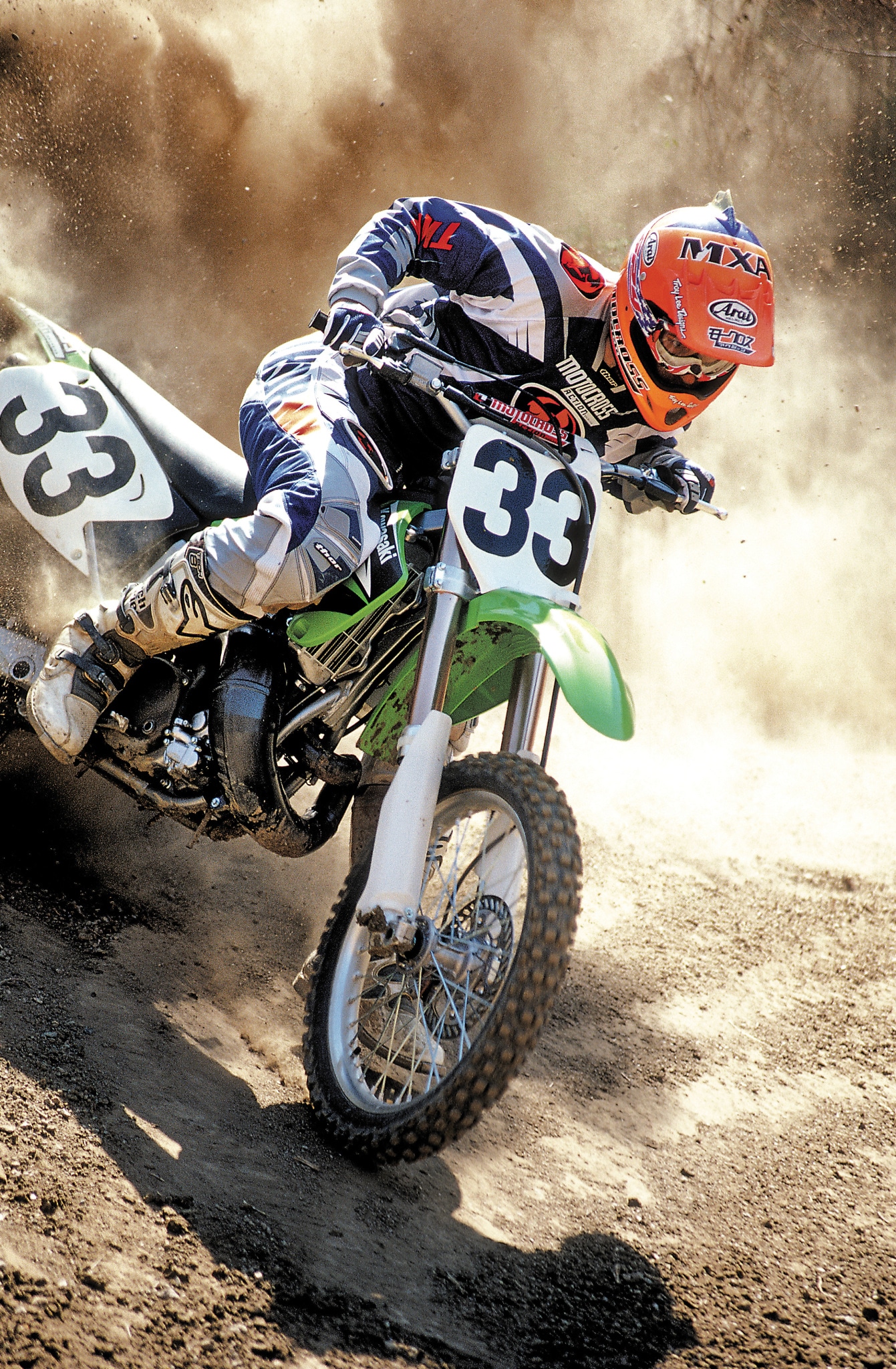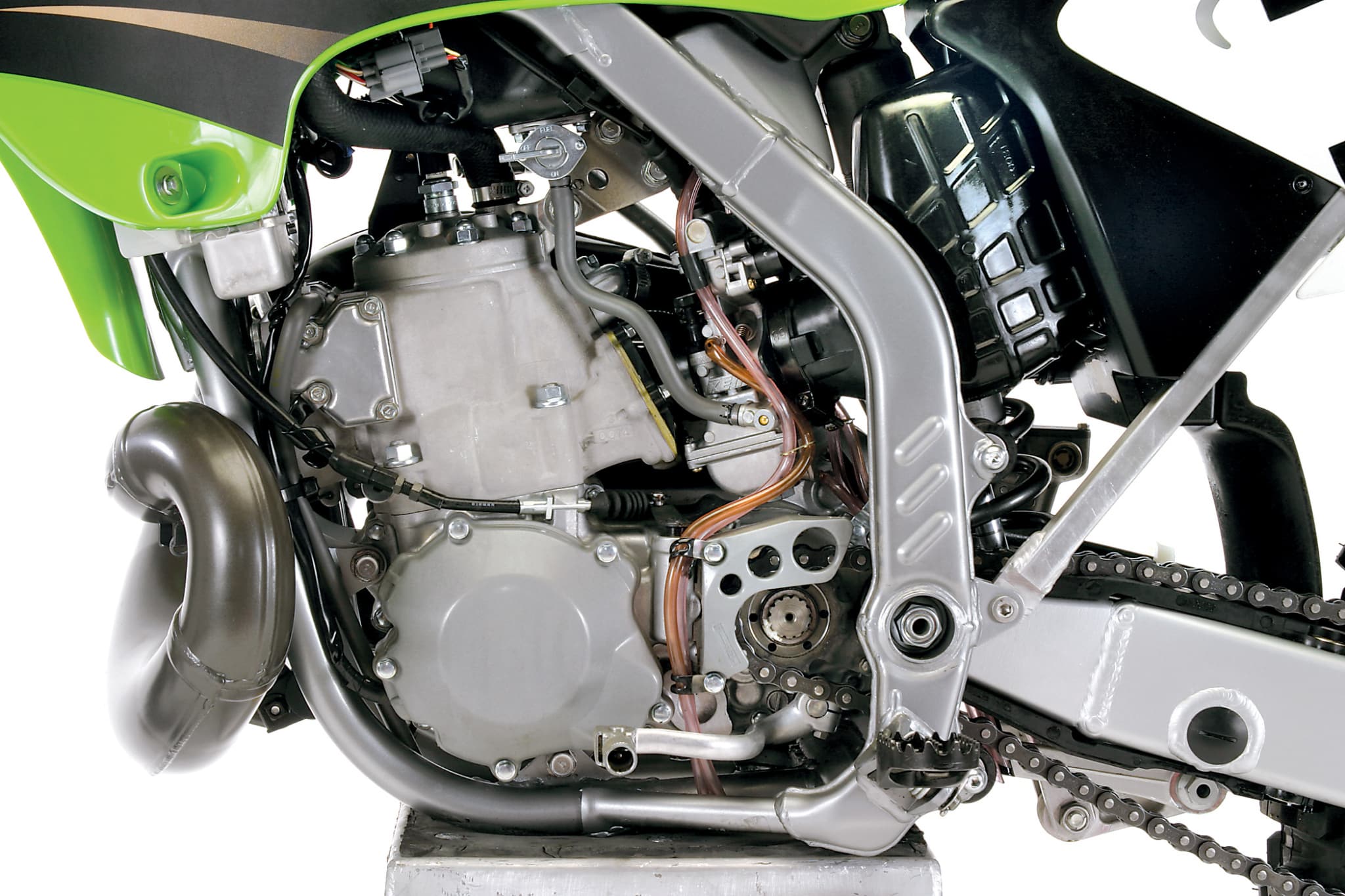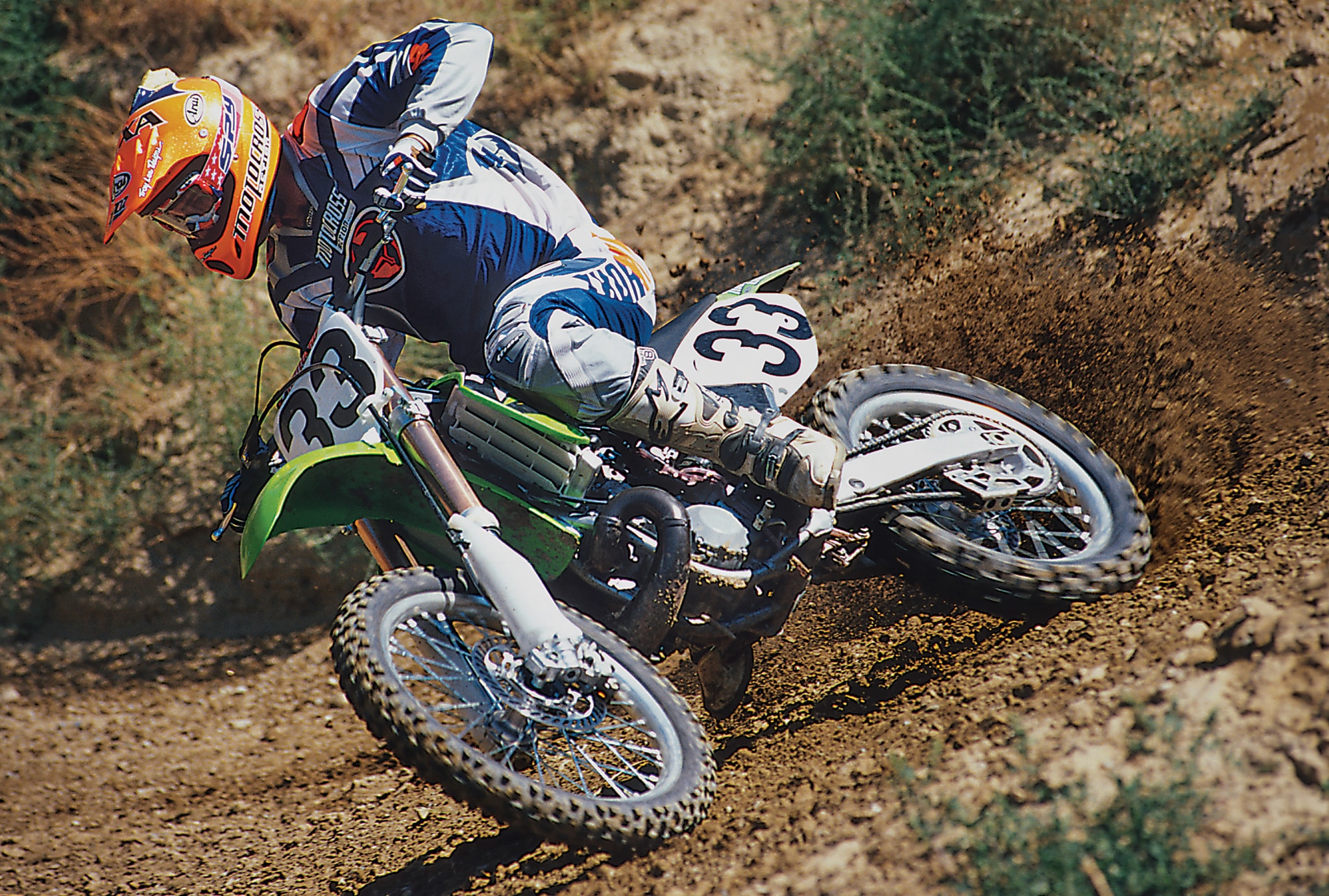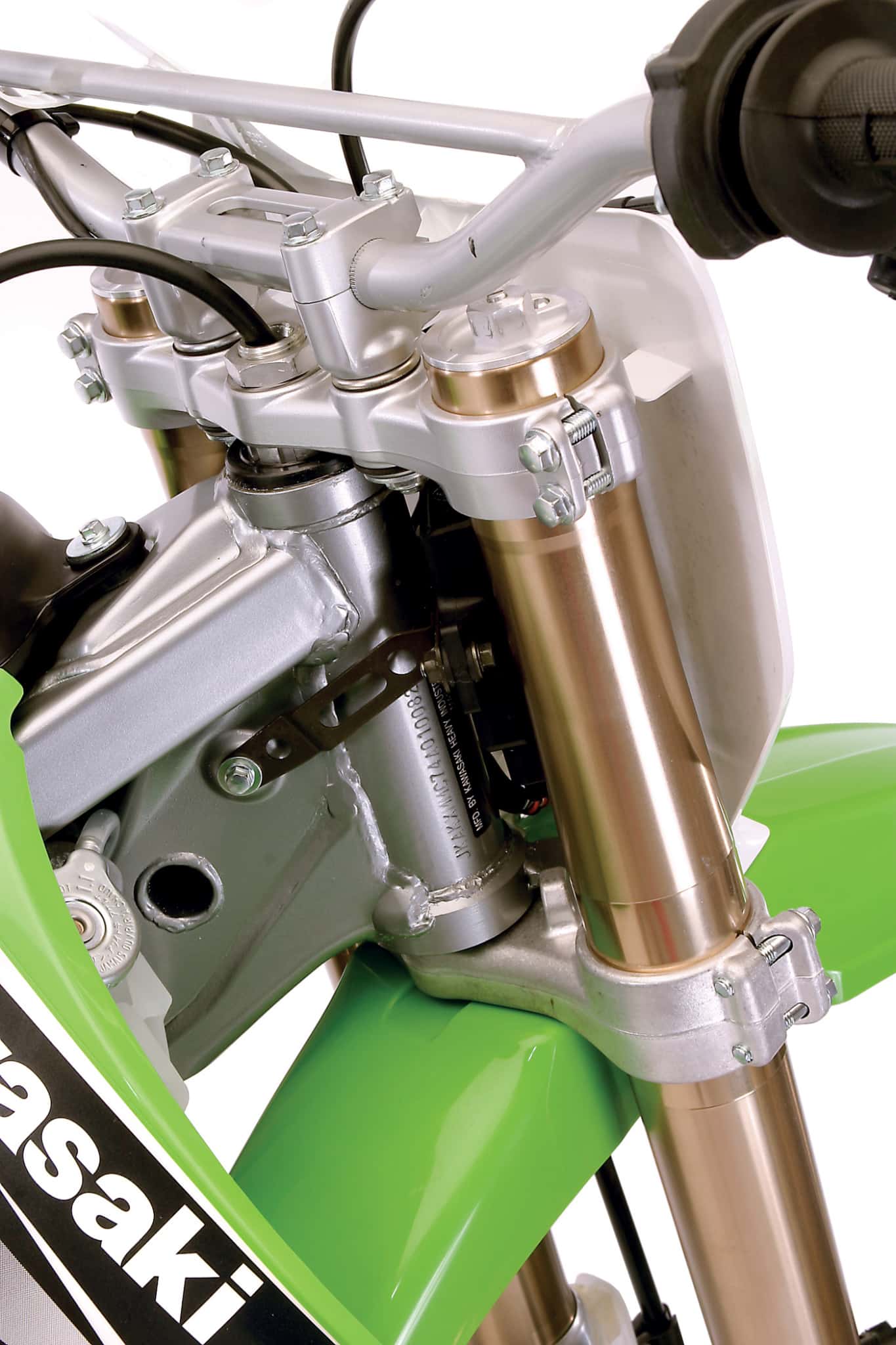MXA RETRO TEST: WE TEST THE UNSYNCOPATED 2004 KAWASAKI KX250
We get misty-eyed sometimes thinking about past bikes we loved and those that should remain forgotten. We take you on a trip down memory lane with bike tests that got filed away and disregarded in the MXA archives. We reminisce on a piece of moto history that has been resurrected. Here is MXA’s test of the 2004 Kawasaki KX250.
It wasn’t long ago that Sylvester Stallone, Steven Seagal and Bruce Willis were action heroes. A decade ago they dominated the box-office receipts and garnered 20 million per movie. But, the days of “Rambo III”, “Die Hard” and “Marked for Death” are long gone. The glory that was, was.
Kawasaki knows how the ex-Hollywood hunks feel, because they, too, once dominated the charts. From 1997 through 1999, the Kawasaki KX250 was the MXA “Bike of the Year.” It was a smash hit. It was on everyone’s A-list. It was the critics’ favorite. Unfortunately, over the last five years, the box-office appeal of the green machine has waned. Can they get it back? Will the 2004 KX250 win an Oscar?
FROM 1997 THROUGH 1999, THE KAWASAKI KX250 WAS THE MXA
“BIKE OF THE YEAR.” IT WAS A SMASH HIT. IT WAS ON EVERYONE’S A-LIST.
Q: IS THE 2004 KX250 ENGINE FASTER THAN LAST YEAR?
A: Yes. But, let’s not get too misty about the 2004 KX250 being faster than the 2003 model. The 2003 KX250 couldn’t crack 43 horsepower on the dyno. And, while the 2004 KX does break the 43-pony barrier, that is no great feat, considering that everyone else is pushing 46.

Q: IS IT FAST OR SLOW?
A: It is slow, but not terminally. Kawasaki worked long and hard to improve throttle response, lighten the rotational mass and broaden the powerband. It is better than it was, but the best adjective to describe the KX250’s potential is “average.”
Q: WHAT ABOUT THE KX250 GEARING?
A: We recommend gearing it down 1 tooth to help bridge the gap from second to third, which seemed large because of the lack of effective over-rev.
IF YOU LIKE TO KEEP YOUR BIKE UPRIGHT, TUCK TO THE INSIDE OF MOST TURNS AND ACCELERATE IN A STRAIGHT LINE, THE KX250’S CHASSIS IS HANDMADE FOR YOUR RIDING STYLE.
Q: HOW IS THE JETTING?
A: Perfect. For MXA’s sea-level racetracks and summer temps, the 2004 KX250 required nothing more than an air-screw adjustment.
Q: HOW GOOD IS THE SHIFTING?
A: Mediocre at best. The clutch has a draggy feel, and the gearbox requires concentration to hit every gear perfectly.

Q: WHAT ABOUT THE 2004 KX250 SUSPENSION?
A: Kawasaki’s Kayaba forks are on their third damping system in three years and, adding to the mix, the rear suspension has been totally redesigned (including the linkage, shock and valving).
Forks: Last year Kawasaki jumped off the bladder-fork wagon and went with bumper forks. This year they retreated from bumper forks to something they call “semi-sealed cartridge forks.” We liked this fork, but it was a little on the soft side, a problem that was made worse by Kawasaki’s front ride height. For some reason, Kawasaki’s engineers want the forks slid up into the clamps. This is a no-no because it drops the front and creates stinkbug city. Set the forks with the legs sticking up 5mm above the top of the clamps. We ran the compression on 12 and rebound on 10.
Shock: In an effort to regain lost ground in the suspension department, Kawasaki chucked their old shock linkage for a new Yamaha-style link. The new linkage changed the rising-rate and shock-deflection angle. Under some loads, the new KX suspension is a thing of beauty, but as a rule it doesn’t like square-edged bumps and requires considerable rebound damping. It has a dead feel and seems over-damped. The lack of high-speed compression adjustment, which Kawasaki pioneered, forces the rider to depend more on race sag and low-speed compression than with comparable systems. We set the race sag at 100mm and the low-speed clicker on 12 out. Rebound varied from 8 to 10 clicks out.

Q: HOW DOES IT HANDLE?
A: If you like to keep your bike upright, tuck to the inside of most turns and accelerate in a straight line, the KX250’s chassis is handmade for your riding style. It is neither as quick as the RM250 nor as stable as the YZ250. It has a middle-of-the-road style of handling that is best described as “workmanlike.”
Kawasaki steepened the head angle for better turn-in last year, and the downside was considerable head-shake (aggravated by the stinkbug stance). On tracks that feature heavy braking or high-speed sweepers, you should slide the forks as far down in the clamps as propriety allows. This will calm down the quiver.

Q: WHAT DID WE HATE?
A: The hate list:
(1) Handlebars: Honda and KTM have upped the ante in the handlebar game. Kawasaki’s old-school steel bars look primitive by comparison.
(2) Clutch adjuster: Everybody has on-the-fly clutch adjustment except Kawasaki.
(3) Gas tank: We don’t like black gas tanks. Never will. You can’t tell if it’s full until the ground is wet.
(4) Saddle: Very soft, although it has gripper material.
(5) Clutch: It needs stiffer clutch springs to free up the mechanism.
(6) Tires: Bridgestone’s M601/602 tires are very one-dimensional. They only work on hard dirt—very hard.
EVERY TEST RIDER FELT THAT THE KX250 HAD GOOD TRAITS BUT DELIVERED
THEM IN A DISCOMBOBULATED WAY. IT IS, IN A WORD, UNSYNCOPATED.
Q: WHAT DID WE LIKE?
A: The like list:
(1) Jetting: It is spot-on.
(2) Pipe: The gray pipe coating is the best thing any manufacturer ever put on a bike. It is durable, non-rusting and trick-looking.
(3) Bar clamps: The eccentric handlebar clamps can be rotated to give a rider two choices of bar positioning (we rotate them forward).
(4) Number plates: Kudos to Kawasaki. Big, visible numbers actually fit on the number plates. What a concept!
(5) Graphics: KTM and Kawasaki have the longest-lasting stock graphics.

Q: WHAT DO WE REALLY THINK?
A: The 2004 Kawasaki KX250 needs about 4 more horses and 500 more rpm before it will be a boffo at the box office. Every test rider felt that the KX250 had good traits but delivered them in a discombobulated way. It is, in a word, unsyncopated.






Comments are closed.